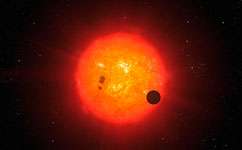Bigger Goldilocks zone increases chance of finding life in space

New research suggests the habitable zone around some stars – the so-called Goldilocks zone – could be up to 30 per cent bigger than previously thought.
This makes it much more likely that life-supporting planets exist elsewhere in our galaxy.
The study looked at the relationship between the radiation from red dwarf stars and the reflective quality – or albedo – of snow and ice cover on orbiting planets.
Red dwarfs are cooler than G-type stars like our Sun and give off energy at longer wavelengths. More of this energy is absorbed by snow and ice than reflected back into space. This warms the planet's surface, melting some of the ice to produce liquid water – a fundamental requirement for life.
"We knew that red dwarfs emit energy at a different wavelength, and we wanted to find out exactly what that might mean for the albedo of planets orbiting these stars," explained Dr. Manoj Joshi from the National Center for Atmospheric Science, who carried out the research in collaboration with Robert Haberle from the NASA Ames Research Center.
Red dwarfs, or M-stars, make up 80 per cent of the stars in our galaxy, and are thought to be very long-lived, so identifying their habitable zones is an important goal.
The albedo effect of snow and ice is important for climate because it is part of what's known as a positive feedback loop. An increase in ice cover reflects more radiation, further cooling the planet and leading to the formation of more ice. Conversely, a loss of ice cover means less radiation is reflected and more is absorbed, which means the planet gets warmer and more ice is lost.
So anything that lowers average albedo will have implications for the climates of ice-covered planets – much more than it would for planets like Earth, which has relatively little ice cover.
Though our ability to see further into space is improving all the time, so far we can only speculate about what planets outside our solar system might be like – how much ocean or land, ice or snow they might have, for example. But scientists have identified actual planets around red dwarfs.
The researchers used the radiation from two red dwarfs, Gliese 436 and GJ 1214, to calculate the effect of longer wavelengths on the albedo of ice and snow for a planet with a surface temperature of 200o Kelvin. This is the temperature at which 1 bar of CO2 condenses, often used as an indicator, or proxy, for the outer edge of the habitable zone – anything below this temperature and a planet would simply be too cold to sustain life.
They found that planets with significant snow and ice cover will have higher surface temperatures under longer wavelength radiation when the effect on the albedo of snow and ice is taken into account. In fact it makes such a difference that the researchers calculate the outer edge of the habitable zone around M-stars may be 10 to 30 per cent further away from the parent star than previously thought.
"Previous studies haven't included such detailed calculations of the different albedo effects of ice and snow,' explains Joshi. 'But we were a little surprised how big the effect was."
This story is republished courtesy of Planet Earth online, a free, companion website to the award-winning magazine Planet Earth published and funded by the Natural Environment Research Council (NERC).
More information: Manoj M Joshi & R Haberle. Suppression of the water, ice and snow albedo feedback on planets orbiting red dwarf stars and the subsequent widening of the habitable zone. Forthcoming in Astrobiology, 2011.
Journal information: Astrobiology
Provided by PlanetEarth Online




















